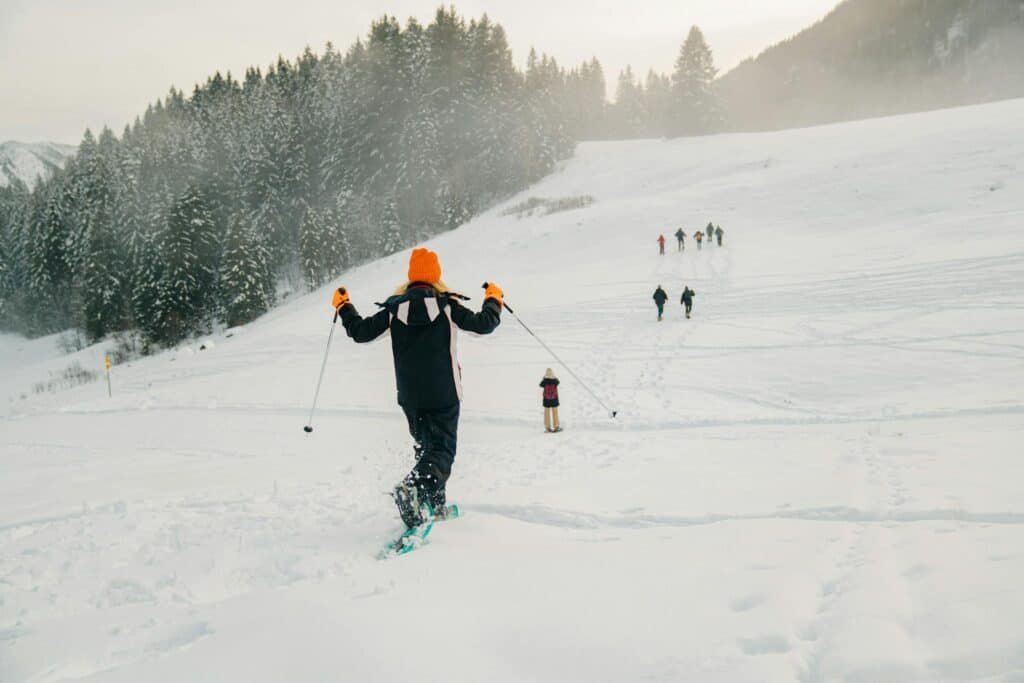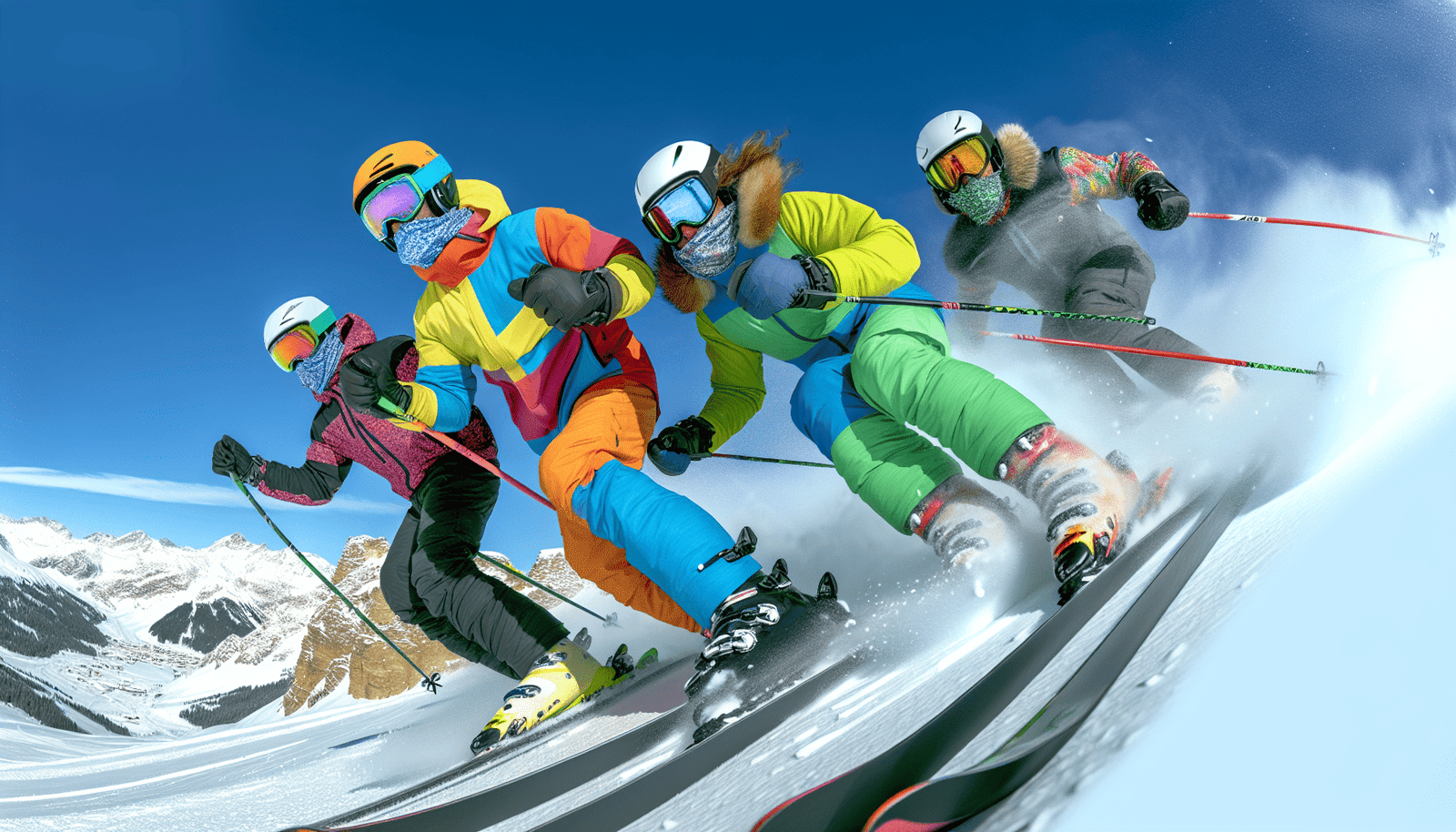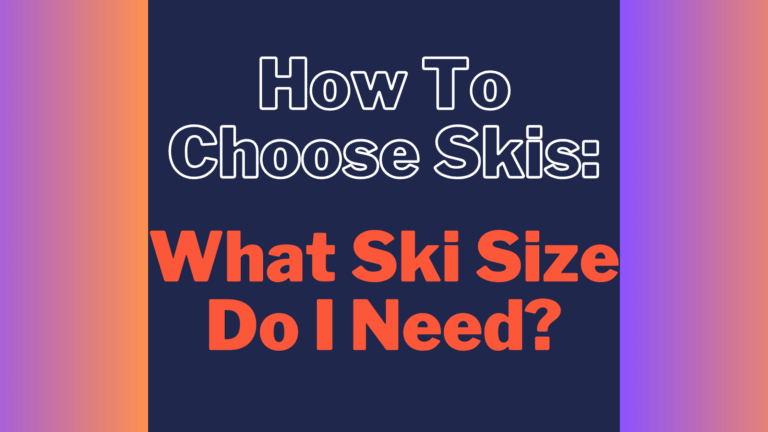Skier Type Classification: What Type Of Skier Are You?

Skiing requires adapting to the mountain’s terrain, much like matching steps in a dance. Success in skiing depends on understanding your skill level and style. Identifying your skier type is crucial for this.
In this guide, we’ll help you determine your skier type, whether you’re a beginner or an experienced skier. We’ll cover the three main skier types, explain the significance of correct ski boot sole length, and guide you in adjusting your ski bindings. Additionally, we’ll offer advice on advancing through different skier types and improving your skiing skills with each run.
Key Takeaways
What Are The Different Skier Types?

Skiing, much like many other sports, categorizes participants based on their skill level and style, leading to the identification of different skier types. These categories help skiers understand their current abilities and set goals for improvement. Here are the primary skier types:
Beginner Skiers: These skiers are just starting. They usually stick to gentle slopes (often referred to as green runs) and are still mastering the basics like maintaining balance, controlling speed, and making simple turns. Beginner skiers often need to build confidence and get comfortable with ski equipment.
Intermediate Skiers: At this stage, skiers have a good grasp of the basics and can confidently handle more challenging slopes (blue runs). They have better control and can perform parallel turns. Intermediate skiers are typically comfortable on a variety of terrains but may still struggle with more demanding conditions like icy slopes or deep powder.
Advanced Skiers: These skiers are experienced and can confidently navigate most parts of a ski resort. They can handle black diamond runs, which are steep and challenging. Advanced skiers are skilled in different snow conditions and terrains, including off-piste (unmarked or unpatrolled areas outside of official ski runs).
Expert Skiers: At the top of the skill ladder, expert skiers can tackle the most challenging terrains and conditions, including double black diamonds, moguls, and backcountry skiing. They have excellent control and can make precise turns at high speeds. Expert skiers often seek out the most difficult and least accessible areas of a mountain.
Freestyle Skiers: This category is more about style than skill level. Freestyle skiers, often equipped with specialized park skis, enjoy performing tricks, jumps, and other maneuvers in terrain parks and halfpipes. They often incorporate elements of gymnastics and are skilled at using rails, jumps, and other features found in snow parks.
Racing Skiers: Focused on speed, racing skiers train to compete in events like slalom, giant slalom, super-G, and downhill. This type involves precise timing, fast reflexes, and a high level of technical skill. Racing skiers often have specialized training and equipment.
Ski Binding Settings According To Skier Type
The Type 1, Type 2, and Type 3 classifications in skiing are not about skill levels or styles like beginner or expert but rather refer to the settings used for ski bindings. These settings determine the force required for the bindings to release the ski boot, which is crucial for safety. Here’s a breakdown of what each type means:
Type 1 Skiers: This setting is for skiers who prefer skiing at slower speeds and are cautious in their approach. Type 1 skiers are often beginners or those who are not very confident on more challenging slopes. The binding setting for Type 1 skiers is lower, which means the ski will release from the boot more easily. This setting reduces the risk of injury during falls, as the ski will detach from the boot with less force.
Type 2 Skiers: Type 2 is a middle-ground setting for skiers with an intermediate skill level. These skiers are comfortable at moderate speeds and on varied terrain, but they are not overly aggressive. The binding setting for Type 2 skiers is higher than for Type 1, meaning the ski will release from the boot under greater force. This setting provides a balance between safety and performance for skiers who have a moderate approach to their skiing.
Type 3 Skiers: This setting is for advanced and expert skiers who ski aggressively and at high speeds. Type 3 skiers are confident on challenging terrain and require a binding that won’t release easily, as the premature release can lead to loss of control. Therefore, the binding setting for Type 3 skiers is higher, allowing the ski to stay attached to the boot even under higher forces. This setting is suitable for skiers who are less likely to fall and are capable of handling higher binding tensions.
Type I: Cautious Skiing on Smooth Slopes
Type I skiers, like new dancers tentatively stepping onto the dance floor, are cautious and favor well-maintained groomed slopes. These individuals are typically entry-level skiers uncertain of their abilities or intermediate skiers who enjoy the gentle rhythm of green terrain and easy blue terrain.
Increased releasability from their ski bindings is vital for Type I skiers. This acts as a safety feature, releasing the skis more readily during a fall or if there’s incorrect technique or balance. It’s akin to a dance partner adjusting their grip to avoid injury during a misstep or stumble.
Providing accurate information about their abilities to the shop technician enables Type I skiers to obtain the correct release retention settings for their ski bindings, striking a balance between safety and enjoyment.
Type I: Increased Releasability
Increased releasability takes center stage for Type I skiers. Just as a beginner dancer needs a partner who can quickly adapt and release their grip in case of a stumble, these skiers need their ski bindings to have an inadvertent binding release more readily in the event of a fall or when incorrect technique or balance is used.
This increased releasability is like a safety net, providing a decreased risk of injury. It’s especially crucial for entry-level skiers uncertain of their abilities or those skiing on smooth slopes of moderate to steep pitch. Thus, having accurate release retention settings is akin to having the right dance partner—one who knows when to hold on and when to let go.
Type II: Confident Recreational Skiing

Type II skiers are the confident swing dancers of the slopes. They are comfortable with most recreational skiing, exhibiting a preference for a diverse range of terrains and speeds. These skiers have graduated from the smooth moves of the waltz to the varied rhythms of the swing, making them suitable for intermediate to advanced skiers.
Mastering a range of skills, akin to a dancer embracing various dance styles, is imperative for Type II skiers to relish their skiing experience fully. From stance and balance to pole planting and carving, these skills are crucial for maintaining control and stability on the slopes. Specifically, Type II skiers should feel comfortable on easy blue terrain, skiing at various speeds, and mastering turns with precision. Some key skills for Type II skiers include:
Stance and balance
Pole planting
Carving
Control and stability on the slopes
Type II: Average Release Retention Settings
Type II skiers require average release retention settings. This is like the swing dancer who needs a partner with a firm but adjustable grip, capable of smoothly transitioning between different moves. These settings offer a balance between safety and performance, allowing these skiers to enjoy the varied rhythms of most recreational skiing.
Striking a balance between safety and performance empowers Type II skiers to maintain control and stability while enhancing their skiing skills and deriving pleasure from the sport. It’s akin to a dance couple moving in sync, their rhythm and pace perfectly matched, their movements fluid and effortless.
Type III: Aggressive and Fast Skiing

Type III skiers are the tango dancers of the skiing world. They are characterized by their assertive and high-speed skiing technique, making them suitable for advanced and expert skiers who seek out demanding terrains and conditions. These skiers aren’t afraid to transition from blue terrain to steeper and more challenging slopes, amplifying the thrill of their skiing experience.
Much like how tango dancers thrive in the spotlight, Type III skiers prefer to challenge themselves on moderate to steeper terrain, particularly in cool and firm snow conditions. They are equipped with high-performance skis, stiff and responsive boots, and bindings tailored for power transmission. But as with any high-intensity dance, safety precautions are essential. These include wearing suitable protective gear, maintaining control and awareness, following the rules and signs of the ski resort, and staying in good physical condition with proper warm-ups.
Type III: Decreased Releasability
For Type III skiers, akin to tango dancers on the slopes, decreased releasability is paramount. Their aggressive skiing style demands a firm grip, requiring more force to release their bindings. This ensures that their bindings won’t release prematurely under the high forces generated by their dynamic and high-speed skiing.
Just as a tango dancer needs a partner who can match their intensity and passion, Type III skiers require ski bindings that can withstand their aggressive style. However, like any good dance partner, these bindings must also know when to let go. Therefore, acquiring the correct release retention settings is vital for these skiers, boosting their performance and safety during their thrilling dance down the slopes.
You can use this DIN calculator from dincalculator.com for guidance.
Measuring Your Ski Boot Sole Length
In the dance of skiing, your ski boots are your dance shoes. And just as a dancer needs shoes that fit perfectly, a skier needs boots of the correct size. This is where the ski boot sole length comes into play. Accurate measurement of your ski boot sole length is pivotal to proper binding settings and overall skiing safety, guaranteeing a firm and precise connection between your boots and your skis.
The ski boot sole length impacts the binding settings by determining the boot’s position on the ski. This in turn affects the force on the binding, influencing the required DIN setting for appropriate release and retention. It’s akin to a dancer adjusting their shoes for the perfect fit—too loose, and they risk stumbling; too tight, and they might restrict their movements. Hence, knowing your boot sole length is similar to understanding your dance shoes thoroughly, promising an optimal dancing or skiing experience.
Importance of Accurate Boot Sole Length
Why is an accurate boot sole length so important? Imagine wearing dance shoes that are too big or too small—they would throw off your balance and restrict your movements. Similarly, an inaccurate boot sole length can result in:
instability
reduced control of the skis
increased risk of falls and accidents
impact on the functionality of the ski bindings’ release mechanism, further elevating the potential for injury during a fall.
Just as a dancer needs to know their shoe size to perform their best, a skier needs to be aware of their boot sole length to ensure proper fitting and select compatible bindings. A correct fit provides necessary support and control; compatible bindings establish a secure connection between boots and skis; and the right boot size enhances balance and control. Consequently, accurate boot sole length is a crucial aspect of a skier’s toolkit, enabling them to glide down the slopes with grace and precision.
How to Measure Your Ski Boot Sole Length
To accurately measure your ski boot sole length, simply measure the distance in millimeters from the heel to the toe of the boot, focusing on the longest points. This measurement is crucial for ensuring the correct fit of your ski bindings,
Always remember to use a MONDOPOINT scale for measuring and to ensure a proper fit in the heel pocket for comfort and stability. With the right tools and a little attention to detail, measuring your boot sole length can be as easy as doing the two-step!
Tips for Progressing Through Skier Types
Like any dance, skiing is a journey of continual learning and improvement. The more you practice, the more your rhythm improves and the more complex moves you can perform. Similarly, progressing through skier types involves improving technique, confidence, and experience on various terrains and conditions. Whether you’re a beginner looking to advance to an intermediate level or an intermediate skier aiming to conquer a more challenging terrain, we’ve got tips to help you elevate your slope experience.
The key is to comprehend your current skill level and establish attainable goals for enhancement. Much like a beginner dancer might start with the basics of rhythm and footwork before attempting complex spins and lifts, a skier must master the techniques and skills appropriate for their current skier type before progressing to the next level. So, lace up your ski boots, secure your bindings, and delve into the advice that will assist you in evolving from one skier type to the next.
Graduating from Type I to Type II
To graduate from Type I to Type II, think of it as moving from a waltz to a swing. The moves get more complex, the rhythm gets faster, and the dance gets more exciting. This transition involves improving technique, balance, and confidence on a variety of slopes and conditions, including mastering control at slower speeds.
From transitioning from snowplough to parallel skiing to increasing edge angle and enhancing balance and control, improving technique is key to graduating from Type I to Type II. Additionally, exercises such as practicing balancing on one leg and performing core-targeted workouts can help enhance balance, akin to a dancer practicing their spins and pirouettes.
Hence, lace up your ski boots, step onto those smooth slopes, and begin polishing your turns and swings!
Advancing from Type II to Type III
Advancing from Type II to Type III is like transitioning from swing to tango. The rhythm gets intense, the moves get fast, and the dance gets more passionate. This transition requires mastering advanced skiing techniques, increasing speed, and tackling challenging terrains and conditions.
To become a Type III skier, you must concentrate on mastering the five fundamentals of skiing, practicing advanced carving techniques, and enhancing turn initiation. It’s like a dancer learning the intricate footwork and dramatic dips of the tango. And just as a tango dancer must maintain control even during the most intense moments of the dance, a Type III skier must maintain control and awareness even on the most challenging terrains.
Practice, persistence, and passion are your keys to graduating from Type II to Type III.
Summary
Just as a dancer leaves the dance floor with a sense of accomplishment and satisfaction, we hope you’re leaving this guide with a heightened understanding of your skier type, the importance of proper ski bindings and accurate boot sole length, and how to progress through the skier types. Remember, skiing, like dancing, is a journey. Whether you’re a cautious waltzer or a daring tango dancer, each turn on the slopes is a step towards improving your rhythm and enhancing your skiing experience.
So, strap on your ski boots, adjust your bindings, and embrace your skiing style. Whether you’re gliding down smooth slopes, twisting through varied terrain, or speeding down challenging descents, remember to ski with confidence, balance, and control. After all, the mountains are your dance floor, and the rhythm of the slopes is your music. Ready to dance?
Frequently Asked Questions
What does it mean by skier type?
Skier type is a classification that determines the difficulty level of a ski run. Type I is for green/beginner skiers, Type II is for blue/intermediate skiers, and Type III is for black/difficult skiers. Bindings are adjusted to ensure that the boots of Type I skiers release more easily than those of more experienced skiers.
What is skier type 3?
Type III skiers are those who prefer fast skiing on moderate to steep pitches and correspondingly receive higher than average release and retention settings for a decreased risk of inadvertent binding release.
What does it mean to be an aggressive skier?
Aggressive skiing means skiing faster than normal speeds, on steeper slopes, with higher release and retention settings, and with decreased releasability in the event of a fall.
What are the different skier types, and why is it important to know my type?
Knowing your skier type is essential in order to select the right equipment and terrain, reducing the risk of injury. The three main types are Type I (cautious skiers who prefer groomed slopes), Type II (confident recreational skiers who enjoy a variety of terrains and speeds), and Type III (aggressive skiers seeking challenging terrain).
How do ski binding release retention settings affect my skiing experience?
Adjusting your ski binding release retention settings correctly ensures your safety and increases power transfer and control, resulting in an enhanced skiing experience.






